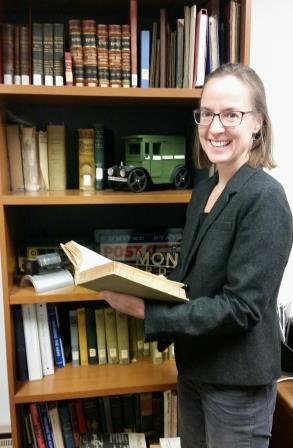
Meet the Keeper of USPS History, Jenny Lynch
This year marks the Postal Service’s 240th anniversary. That’s a lot of history to keep track of – but luckily, USPS Historian Jenny Lynch is pretty incredible at her job. She has served as Senior Research Analyst in Postal History for nearly four years, after working for the Postal Service for 20 years under previous historians.
When employees, stakeholders and members of the public need information on everything from vintage stamps to airmail pilots – Lynch can help them find it. She is well versed in all aspects of USPS history, and enjoys digging into research and sharing her fascinating findings. Read on to learn more about Jenny and the important work she does for the Postal Service.
What are your key responsibilities/roles?
I respond to requests for historical information from postal employees and the public, fact-check historical references in USPS speeches and news articles, write about postal history for management, the USPS history webpages, and publications. I also manage the Postal Service’s collection of historical artifacts, records, and photographs, as well as the USPS Corporate Library. My office manages the content of the Postal History webpages and maintains Postmaster Finder, the Postal Service’s national historic record of Postmasters by Post Office.
What’s the best part of your job?
I love to write, and this job gives me plenty of opportunities to do that. I also like the work environment — my colleagues are friendly and supportive. But most of all, I love to research and learn new things, and I constantly get to do this. Every new question or writing project is an opportunity to learn something new.
What’s the biggest challenge you face or have faced?
Doing interviews (ha ha), and public speaking. I’m quiet, reserved, and sort of bookish by nature — the public aspect of my job sometimes makes me uncomfortable.
Also, although it’s not a current challenge, I’m concerned that the “digital dark ages” will be a big challenge for all of us in the future. Historical research depends upon written records; today’s digital-only platforms make information more vulnerable to format changes and potentially more ephemeral, because information is so easily deleted or revised. And information that survives may be less valuable to future researchers. Emails, for example, tend to be less informative than letters — they may contain just a single word, or no words at all, just a smiley face.
How did you become a postal historian? What is your background?
I became USPS historian in 2012 after having worked under the first two historians for about 20 years. In that time, I gradually advanced from “Records Clerk” to “Senior Research Analyst, Postal History.”
My first love was language — I “majored” in French in high school and in Russian Area Studies in college. I applied for a temporary summer job at headquarters during college and, as luck would have it, was interviewed by the first postal historian, Rita Moroney. The rest is … um, never mind.
In your opinion, what’s one of the most interesting moments in Post Office history?
Airmail pilots risking their lives to get the mail through. The first airmail pilots were daredevils. They flew by the seat of their pants. They’d put out engine fires by sending their plane into vertical dives. Before navigational aids were perfected, pilots sometimes got lost and had to land their planes to ask for directions. Weather was so unpredictable, and crashes so common, that pilots would sometimes pack snowshoes and cans of food when they crossed mountains in winter. Thirty-one pilots were killed from 1918 to 1926. Many more crashed and survived — in that same period there were more than 5,000 forced landings.
What is the one thing you would most like people to know about what you do?
The USPS Historian’s Office and Corporate Library are public resources. If you have a question about postal history, feel free to contact us.
Also, we serve a dual role — we help provide access to historical information, and also help preserve postal history for future generations. That means everything from saving obsolete postal manuals, to saving old forms, to preserving examples of all types of postal equipment. If you’re a postal employee and find a rare, obsolete record or item in your facility, don’t throw it out — contact us! Although the USPS Historian’s Office is separate from the Smithsonian’s National Postal Museum, we frequently coordinate the transfer of postal artifacts to the museum’s collection.
#USPS240